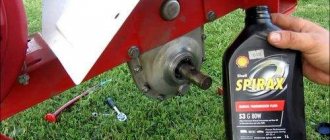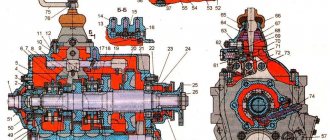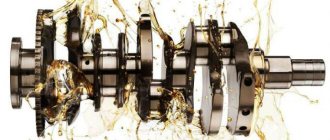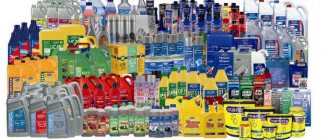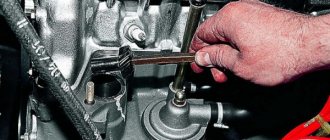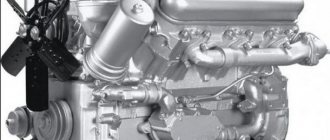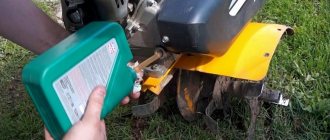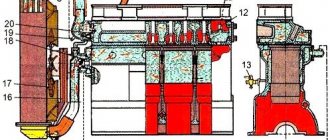Availability of high-quality elements in any equipment – the key to its safe and uninterrupted operation for a long time. But the presence of oil to lubricate the parts is also important. Without it, the engine will not last long, and soon the entire walk-behind tractor will have to be replaced or repaired. Oil is necessary for all systems and components to work without rubbing. This improves performance and increases service life.
Oil must be selected according to its intended purpose . Various lubricants are produced for the motor, transmission, and gearbox. Plus, you need to consider what fuel the engine runs on (gasoline or diesel). Also, some manufacturers immediately indicate what kind of oil a person should pour into the walk-behind tractor. If you do not follow their recommendations, you can significantly reduce the life of your equipment.
To understand what kind of oil to pour into a walk-behind tractor, you need to understand their types . The first division of oils is carried out according to the type of engine - two or four stroke. Next comes the difference in composition - semi-synthetic or synthetic. Oils are also distinguished by what time of year they will be used - summer, winter and all-season. Only by taking into account all the factors can you choose a lubricant that suits the walk-behind tractor.
What kind of oil should I pour into the walk-behind tractor gearbox?
The gearbox can be filled with transmission oil specified by the equipment manufacturer or selected from the available list. If the manufacturer does not indicate what cannot be used, then the oil is selected according to the parameters of the device. To select, you need to look at the letter and number designations. What can you find on a bottle of oil:
- SAE - oil viscosity. On the packaging there is a letter W, to the left of it are sub-zero temperatures, and to the right are positive ones. This way you can understand at what time of year and under what temperature conditions the lubricant will work well.
- API – type of engine fuel. There is a letter S next to it - this is for gasoline, and if C, then for diesel 4-stroke.
- ACEA is an energy saving indicator. If the load on the walk-behind tractor is high, then it is better to take oil with the maximum rating. The higher the numbers, the more protected the equipment will be from wear.
There are several most common types of oils:
- 10w30 , 10w40 - all-season, characterized by high anti-corrosion properties.
- 0w30 , 0w40 - suitable for use in winter.
- 15w40 , 20w40 - used at high temperatures.
- 5w30 , 5w40 - all-season, can be used if the street is not lower than -25 degrees.
There are also “win-win” options. If the packaging is marked with paired letters - SG/CD or SF/CC, then the lubricant is suitable for any walk-behind tractor with any fuel.
Considering that walk-behind tractors are used more often in the summer, all-season or anti-corrosion oils are more in demand, which extend the life of the equipment. The oil manufacturer can be any one, but often the brands on the shelves are ZIC, Mobil, Shell Helix and Castrol, which have shown a good price-quality ratio.
What kind of oil should I pour into a walk-behind tractor engine?
To prevent the engine from overheating and its parts from rubbing against each other, it is necessary to use a lubricant. What kind of oil to pour into the engine of a walk-behind tractor depends on the type of fuel on which it runs. For diesel equipment, you should choose a lubricant based on the following considerations:
- Category CA is suitable for walk-behind tractors with light loads.
- SV - lubricants are used if the fuel has a high sulfur content.
- Grease marked CC is suitable for walk-behind tractors that do not have turbocharging and operate at high load levels.
If you use properly selected oil for a walk-behind tractor engine, you can reduce fuel consumption and increase productivity (equipment life).
For walk-behind tractors with gasoline as fuel, you need to choose oil according to a different marking:
- SA – the equipment is not heavily loaded.
- SB – the device can withstand medium load levels.
- SC – if the engine does not have PCV valves.
- SD – if PCV valves are installed.
- SE is an oil for walk-behind tractors with engines manufactured in 1980.
- SF is similar to the previous lubricant, but the quality is better (less agar).
- SH – universal for different systems.
Regardless of what fuel the walk-behind tractor uses, you should first read the manufacturer’s instructions before purchasing liquid. Many companies even produce their own oils, which are tested at the factory and are really well suited for equipment. It is not necessary to give preference to recommended products, but then it is better not to skimp on oil and choose high-quality lubricant from a trusted company. Otherwise, there is a possibility of quickly “killing” the walk-behind tractor engine and spending more money on equipment repairs.
Level check
To control the level in the engine crankcase, most models have a dipstick with min and max marks (minimum/maximum). When the dipstick is pulled out of the crankcase, oil remains on it, which shows the amount. If the level seems inaccurate, wipe the dipstick completely with a rag, reinsert it into the crankcase and pull it out. The oil always remains on the dipstick and shows its level.
It is believed that it is impossible to pour oil into either the gearbox or the engine of a walk-behind tractor. It will not be possible to fill above the edge of the hole, as it will immediately flow back. And the level along the edge of the hole is acceptable for the engine. In a gearbox it is considered normal. For this reason, the gearbox does not have an oil level dipstick.
To control the oil level in the gearbox, you can use a handy dipstick - a piece of wire, etc.
However, for some engines, overfilling the crankcase is unacceptable. This can lead to an increase in pressure inside the assembly, squeezing out seals and gaskets, and splashing. If the piston rings and cylinder bore are worn out, oil can get into the combustion chamber and onto the spark plugs, which is extremely undesirable. Therefore, it is better to fill the engine with oil according to the recommendations in the Instructions.
The quantity and quality of oil must be monitored; the service life of the entire walk-behind tractor depends on this.
Some are changed every year in the spring, before the start of the season. Other owners haven't changed it for years. Still others install an hour meter and change it according to the manufacturer’s recommendations. For example, every 500 operating hours.
It makes sense to change the oil after break-in, since at this time it may contain small sawdust and metal shavings that are formed during the grinding in of new components. These inclusions in the oil are extremely undesirable, since they themselves already lead to wear and abrasion of the components.
What kind of oil should be poured into the transmission of a walk-behind tractor?
The transmission is complex in design and has many parts. Therefore, it is also necessary to have lubricant to prevent frequent breakdowns. What kind of oil to pour into the box of a walk-behind tractor is mainly selected based on the degrees at which the walk-behind tractor is planned to be used outside. If there is only a number on the oil package, then this is an indicator of the positive temperature at the upper limit. Winter oil always has a mark in the form of the letter W, and if numbers are added to this letter on the sides, then it is an all-season oil indicating permissible temperatures. Examples of how oil in a walk-behind tractor transmission is marked:
- 20W40 – -15° – +45°.
- 15W40 – -20° – +45°.
- 10W40 – -25° – +35°.
- 0W30 – -35° and below – +25°.
- 0W40 – -35° and below – +30°.
- 5W30 – -30° – +25°.
- 5W40 – -30° – +35°.
- 75W90 and 75W80 – -40° – +35°.
- 80W85 and 80W90 – -25° – +35°.
- 85W90 – -12° – +45°.
When choosing which oil to pour into the transmission of a walk-behind tractor, you need to look to see if there are the letters “TM” on the label. If they are missing, then the lubricant is not suitable for the transmission.
It is best to give preference to oils that protect equipment from corrosion - this is the main enemy. The faster plaque and rust appear, the less the walk-behind tractor will last. Therefore, it is better to pay for high-quality oil according to the season, but with anti-corrosion properties. But buying an all-season vehicle may turn out to be less economical if the equipment quickly deteriorates.
A few specific examples of what oil to take based on the brand of the walk-behind tractor:
- MTZ -05 – oils M-8G1, M-8B1 and M-8B1.
- Neva MB-1 – TAP-15V, TAD-17I.
- Neva MB-2 – TM-5, SAE90 API GI-5, TEP-15, SAE90 API GI-2.
- Agat - MS-20 and TAD-17I.
- Bison - TAP-15.
- Ugra NMB-1 – TCn-10.
All these oils are constantly on sale, and finding the right lubricant is not difficult.
Oil for diesel walk-behind tractors
Motoblocks based on diesel fuel are very common and are often used in agriculture. Depending on the type of equipment, oil is selected. And here everything is quite simple, it is not possible to come across 2-stroke walk-behind tractors; these are most often cultivators. All walk-behind tractors are four-stroke, and you need to take oil according to this functional feature.
There are three types of oils - synthetic, semi-synthetic and mineral - as all car owners will say. But if oil is chosen for a walk-behind tractor or other gardening equipment, then there are only two options:
- Semi-synthetic . Belongs to the budget segment. Great for summer and warm autumn and spring. In winter, walk-behind tractors are rarely used, but if you plan to take the equipment out into the cold, then you cannot use semi-synthetics, it will thicken.
- Synthetics , also known as mineral oil. Such lubricants are universal and can be used year-round. If a bottle of oil is marked W (Winter), then this product can be used at sub-zero temperatures. There are also all-season options, you just need to look at the numbers on both sides of the letter W - this is the temperature range.
Motor oil is produced by many manufacturers . Lubricants from the brands Mannol, Silver, Diamond, Mobil, Motul are very popular. They are affordable, suitable for any walk-behind tractor, and are most often found on sale in all-season vehicles. There are also oils with anti-corrosion properties. Oil marked 0w30, which can withstand both -35 and +25 degrees, has proven itself well. Also popular are 10w30 and 10w40, which have slightly different ranges.
Device
The gearbox is a special device included in the design of any walk-behind tractor. It is this part that is responsible for converting and transmitting torque that is generated from mechanical transmissions. In fact, the gearbox powers the walk-behind tractor, making it work.
The service life of the entire walk-behind tractor, as well as its normal functioning, will depend on its quality, as well as on the correct lubrication of its components.
For more details about the gearbox, watch the video:
Depending on the model of the walk-behind tractor, be it Cayman, Patriot Ural, Patriot, Texas, Foreman or some other, the gearboxes may differ from each other in some design features. Conventionally, gearboxes can be divided into several types:
- Angular reducers. Such units are quite effective and allow you to couple the engine and transmission.
- Gear reducers. In this case, the gearbox transmission acts as a kind of intermediary between the engine and the wheelbase of the walk-behind tractor.
- Reduction gearboxes. These units achieve an increase in power indicators by reducing the total number of revolutions. Such gearboxes are most preferable because their design includes an air cooling system, which allows them to operate at maximum loads.
- Reverse gearboxes. The main advantage of such gearboxes is the ability to reverse the walk-behind tractor. However, units equipped with this type of gearbox do not show high performance indicators and speeds.
Regardless of which gearbox is used in the design of the walk-behind tractor, they all consist of almost the same components:
- shaft;
- gear housing;
- flange and its fastening;
- pulley with V-belt drive (or chain);
- ball bearing;
- stars;
- drain plug;
- steel washer and nut;
- input shaft
These components traditionally form the gearbox itself. and service life will depend on how well they are
Gearbox
Otherwise, if there is insufficient lubrication, the parts will wear out greatly, because they come into contact with each other during operation, and the resulting friction negatively affects their surface.
What kind of oil should I put in Shtenli walk-behind tractors?
] Shtenli[/anchor] walk-behind tractors in the instructions for each equipment gives recommendations on the type of oils used, replacement rules and frequency. Most devices are four-stroke, so it is prohibited to fill the container with oil for 2-stroke engines.
(API classification) are better suited ; SAE 30 and SAE 40 work excellently . But you also need to look at what degrees the motorcycle will be used on the street. The viscosity of the lubricating fluid depends on this. You should not allow the oil to thicken at minus temperatures, as this will lead to damage to the walk-behind tractor. So SAE 30 will work from -5 to +35 degrees, and SAE 40 from +10 to +40 degrees Celsius.
It is important to know not only what kind of oil to pour into the walk-behind tractor, but also how often to do it . After purchase, you need to immediately pour oil into the engine, since the manufacturer Shtenli does not do this at the factory. Next, you should completely change the lubricant with a new one after 5 hours of running the engine. Subsequent oil changes are carried out after 25 hours of active operation. All further replacements must be carried out every 50 hours of operation of Shtenli devices.
The manufacturer also gives instructions on changing the lubricant in the gearbox of any of the Shtenli walk-behind tractors. The requirements for the type of lubricant are the same. Every 150 hours of operation it is worth completely changing (filling in new) lubricant into the gearbox. If you do not follow the instructions, there is a high risk of engine failure. In this case, the walk-behind tractor will not be repaired under warranty service, because the recommended rules for its operation were violated.
Classification of oil grades
To increase the service life of a gasoline or diesel engine, you need to make the right choice of engine oil. Failure to replace it in a timely manner reduces the service life of the engine. How to choose it, in what quantity, how to pour it into the walk-behind tractor - we’ll talk about this in more detail.
Each mini-tractor or walk-behind tractor includes instructions and a product data sheet. In the instructions, the manufacturer lists suitable types of fuel and lubricants that can extend the life of the equipment. Engine oil performs the following functions:
- cooling;
- lubricants;
- seals;
- cleaning.
During air cooling, the lubricant settles on the walls of the hot cylinder. These deposits contaminate engine parts and complicate lubrication processes. Therefore, the lubricant contains antioxidant additives. They clean the cylinder walls from carbon deposits and extend the service life of the walk-behind tractor. Different climate zones require the use of different oily liquids. They differ in viscosity, composition and purpose.
By viscosity
Viscosity is determined according to SAE J300 standard. For mechanisms it depends on the following characteristics:
- unit design;
- features of work;
- age of the mechanism;
- ambient air temperature.
Motor oils are divided into winter and summer. Winter ones are designated with the letter W. Low-viscosity winter grades are often used with SAE designations 0W, 25W, as well as intermediate values 20W, 5W, 15W and 10W. Compositions for use in summer do not have letters in their names. They are distinguished by high viscosity and are designated SAE 20, 60, SAE 30 or 40. When using summer brands in winter, problems arise associated with starting the unit. Winter varieties are not capable of providing high-quality lubrication in the summer.
Scientists have developed all-season compositions that are used for pouring into walk-behind tractors in summer and winter. Their designations are 5W-40, 10W30.
By composition
In addition to seasonal characteristics, lubricants are divided into types based on composition:
- mineral;
- synthetic;
- semi-synthetic.
An air-cooled engine heats up quickly during operation. Motor oil reduces its temperature. The wrong category causes a breakdown in the motor. It is not recommended to use synthetic oil in mixture with mineral oil.
By purpose
If there is a need to replace lubricating fluids, each manufacturing company recommends filling in its own brand. For agricultural machines, Honda uses all-season grades 10W-30 of the SF category. Subaru in its recommendations indicates 10W-30 for operation in moderate climates, and 5W-30 in cold regions. Oil quality category - SE.
Lifan products require summer grade SAE-30, and SAE 10W-30 for winter conditions. There are no conditions for quality category. Motoblocks of the Kaluga Engine company are filled with an all-season composition 10W-30 or 15W-30 of SF or SH quality.
Is it necessary to add oil to gasoline for a walk-behind tractor?
Motoblock engines come in two types : two-stroke and four-stroke. What the device’s engine runs on is also important – diesel or gasoline. Owners of diesel walk-behind tractors do not have a question about whether it is worth adding oil to gasoline. Plus, all four-stroke walk-behind tractors are diesel, so we put them aside; here, oil is not added to the fuel.
For gasoline-powered vehicles with a two-stroke engine, you need to add oil to the gasoline. This is done in the following proportions - 1 part oil and 4 parts gasoline. So if the engine is designed for a volume of 1000 liters, then 200 ml of oil and 800 ml of gasoline are poured into it. The manufacturer of the walk-behind tractor indicates in the instructions which oil to fill. Therefore, there are no clear restrictions, you just need to look at the weather. After all, there are three types of oils - summer, winter and general for all seasons.
Is it possible to fill a walk-behind tractor with motor oil?
This question can be answered affirmatively if the owner has a vehicle with a 4-stroke engine. Regular car oil can easily be used for this. But you should still select it based on climatic conditions. If you plan to use the walk-behind tractor in the summer, it is better to give preference to SAE oils. They are designed for above-zero temperatures, and some options can even withstand extreme heat - +40+45°C. If you need to use a walk-behind tractor only in winter (which is very rare), then automotive lubricants marked 30w, 20w, 10w, 0w and others are suitable. And if you need an all-season option for wide temperature fluctuations, then you need to buy car oil that has numbers to the left and right of the letter “w”.
Car oil is not suitable for owners of two-stroke walk-behind tractors. Their engine is designed only for well-purified liquid. Incorrectly selected oil will lead to engine damage.
Why is the car not suitable?
Among automobile oils there are many special ones, with various additives, which are not suitable for walk-behind tractors.
For example, it is not recommended to use the TM 5 transmission for walk-behind tractor gearboxes. This special oil with a high content of protective and restorative sulfur-phosphorus additives is used only where it is recommended.
On the gearboxes of the walk-behind tractor, it can form protective deposits, films of considerable thickness, which cannot be washed off in this unit and are not needed. This can lead to changes in tooth sizes and problems.
The same applies to special motor oils. In addition, such oils are often much more expensive.
Therefore, it would be more accurate to say that automobile oils are suitable for walk-behind tractors, but not all. I hope we have fully answered the question and now you understand whether it is possible to pour automobile oil into a 4-stroke walk-behind tractor engine.
How much oil is required for a walk-behind tractor engine?
It all depends on its volume . For gardening equipment with an engine of up to 8 horsepower, 0.6 liters of lubricant is sufficient. If the walk-behind tractor has 9-10 hp, then 1 liter of oil will be enough. You can pour 1.1 liters of oil into all other walk-behind tractors that have 11, 13, 14, 16 horsepower. After all, the difference in engine volume is small.
Knowing what kind of motor the walk-behind tractor has, you can easily choose the type of oil and its quantity. You should always read the walk-behind tractor manufacturer's instructions, and then there will be no difficulties with operating the equipment.
And you should not confuse the gearbox and the engine, because they require different amounts of lubricant. The transmission oil box will require more - from 1.5 to 2 liters on average, and sometimes 2.5 liters. The fewer horses a motorcycle has, the less lubrication will be required for its gearbox. The largest amount of oil is poured if the walk-behind tractor has 16 horses (like the Profi 1900 Pro or Centaur 2016B).
Popular models
Those who choose equipment for their garden most often buy the following models of Agat walk-behind tractors.
| Salyut-5 | HMD-5.5 | L-6.5 | BS-6 | R-6 | |
| Engine | Lifan | Hammerman | Lifan | Briggs&Stratton | Subaru |
| Motor power, hp | 6.5 | 5.5 | 6.5 | 6.0 | 6.5 |
| checkpoint | 6 (4/2) | 6 (4/2) | 6 (4/2) | 6 (4/2) | 3 (2/1) |
| Fuel tank volume, l | 3.6 | 3.5 | 3.6 | 2.8 | 3.0 |
| Plowing depth, cm | 25 | 25 | 25 | 25 | 30 |
| Weight, kg | 78 | 85 | 82 | 78 | 84.7 |
How to check the oil level?
You can use the ordinary human eye to check the oil level. If, when pouring, you can see that the liquid is creeping up to the top, then it’s time to stop. But this method is extremely unreliable and is only suitable for emergency situations. To make sure that there is enough oil, it is in the middle between “minimum” and “maximum”, you should use a dipstick .
The dipstick plug is a special device that is screwed into the neck of the walk-behind tractor engine. Before use, the dipstick must be wiped dry and then screwed in until it stops. Afterwards it is removed and the remaining oil liquid is judged. The device has clearly marked boundaries. If the fluid level is normal, you can continue working.
One important rule is that you cannot measure the oil level immediately after turning off the walk-behind tractor. You need to wait 2-3 minutes for the liquid to cool and sink to the bottom of the engine crankcase. Only such a measurement will be correct. Otherwise, you may get an overestimate. And using equipment with insufficient lubrication risks rapid failure.
A few more simple tips
The issue of buying oil confuses beginners - owners of walk-behind tractors - at a dead end. There is nothing wrong with contacting a consultant in a store. But it’s best to still look at the factory’s recommendations. Trying to save on oil can lead to expensive repairs to the walk-behind tractor. What other advice can you give on this topic:
- It is important to change the oil regularly , looking at the time the walk-behind tractor has worked. Therefore, it is better to keep a notebook in which to record operating hours of the equipment.
- The oil for the gearbox and transmission can be the same ; there is no need to overpay for different fluids.
- If it is not clear what engine it is, then you should look at its registration certificate . 2-stroke engines have one piston, while 4-stroke engines have two or more pistons.
- The marking on the oil bottle always shows the operating temperature . Don’t look for the “+” and “-” signs, they won’t be there. If the number to the left of the letter W is a minus, and to the right is a plus.
Changing the oil is not difficult. Now on the Internet and even in the instructions for the equipment, the procedure for doing so is completely prescribed. Just be sure to find an option specifically for the walk-behind tractor model.
Where can I buy?
You can buy lubricant of decent quality and at a reasonable price in the Gardenshop store. The store offers owners of motor-cultivators, walk-behind tractors and mini-tractors the best analogue of SAE 30 - high-quality SCOUT 10W40 oil. It has good lubricating properties and high energy-saving ability, prevents the formation of harmful deposits and is resistant to elevated temperatures. Remember that an oil change is essential maintenance for any engine.
You can purchase original motor lubricant at Gardenshop at the lowest price in the region - only 380 rubles per liter! Anyone who trusts the recommendations of professionals buys SCOUT four-stroke oil!
Results
Every equipment owner can understand how much oil and when to pour into a walk-behind tractor. First of all, the accompanying documentation for the device helps with this. Therefore, you need to read it first and then make a purchase. The choice of motor oils is wide; there are no bad or good options. Yes, they differ in price, but this is not always an indicator of quality. You just need to choose an oil that is suitable for the temperature in which the walk-behind tractor will operate. And if it also protects equipment from corrosion, then this is generally ideal. But the brand is a matter of taste. In both the budget and more expensive segments you can find high-quality motor oils for walk-behind tractors.
Prices
High-quality four-stroke oils for walk-behind tractors are produced by companies from different countries, including Russia, France, Germany, Sweden, and the USA. A wide price range and variety of products allows you to choose the best option for any piece of small-sized agricultural machinery.
The table shows average prices for the most popular types of lubricants for four-stroke internal combustion engines.
| Price in rubles | |
| CARVER SAE 30 (0.95 l) | 290 |
| Husqvarna SAE 30 (0.6 l) | 400 |
| Patriot Supreme HD SAE 30 (0.95 l) | 550 |
| G-MOTION 4T 10W-30 (0.95 l) | 430 |
| SCOUT 10W40 (4 l) | 1520 |
In order for a walk-behind tractor or cultivator to be durable and perform its functions efficiently, it is necessary to create optimal conditions for engine operation: troubleshoot problems in a timely manner and lubricate rubbing surfaces. It is important to use only suitable motor oil to lubricate parts in friction areas. It should be purchased based on the technical requirements of the power plant and the actual conditions of its operation.
